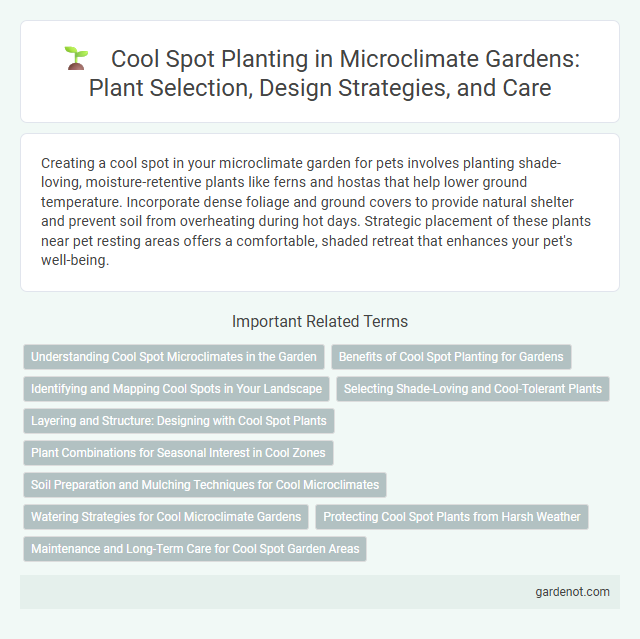Creating a cool spot in your microclimate garden for pets involves planting shade-loving, moisture-retentive plants like ferns and hostas that help lower ground temperature. Incorporate dense foliage and ground covers to provide natural shelter and prevent soil from overheating during hot days. Strategic placement of these plants near pet resting areas offers a comfortable, shaded retreat that enhances your pet's well-being.
Understanding Cool Spot Microclimates in the Garden
Cool spot microclimates in the garden occur in areas with shade, moisture retention, and reduced sun exposure, creating ideal conditions for heat-sensitive plants. Understanding these microclimates involves identifying natural features like tree canopies, shaded walls, or depressions that maintain lower temperatures and higher humidity levels. Selecting plants adapted to these cool spots enhances growth potential, improves soil moisture conservation, and supports biodiversity within the garden ecosystem.
Benefits of Cool Spot Planting for Gardens
Cool spot planting enhances garden microclimates by strategically placing shade-tolerant and moisture-loving plants in cooler, shaded areas, reducing heat stress and conserving soil moisture. This practice boosts plant health and biodiversity by creating microhabitats that support a wider range of species and improve overall ecosystem balance. Optimal placement of cool spot plants can also increase garden resilience during heatwaves and droughts, ensuring sustained growth and productivity.
Identifying and Mapping Cool Spots in Your Landscape
Identify cool spots in your landscape by observing areas with natural shade, proximity to water features, or dense vegetation that reduces temperature fluctuations. Use temperature sensors or thermal imaging to map these zones accurately, noting their microclimatic characteristics such as humidity and airflow. Prioritizing these cool spots for planting heat-sensitive species enhances plant survival and overall garden resilience.
Selecting Shade-Loving and Cool-Tolerant Plants
Selecting shade-loving and cool-tolerant plants such as hostas, ferns, and astilbes creates a lush microclimate garden that thrives in lower light and maintains moisture. These plants reduce soil temperature and provide natural cooling effects, enhancing the comfort of outdoor spaces. Incorporating diverse species like heucheras and pulmonarias further optimizes shade resilience and microclimate balance.
Layering and Structure: Designing with Cool Spot Plants
Layering cool spot plants in a microclimate garden maximizes shade and moisture retention, creating a natural cooling effect. Strategic placement of tall canopy plants, mid-level shrubs, and low ground covers enhances airflow and reduces soil temperature. This structured design promotes a resilient, energy-efficient environment ideal for heat-sensitive species.
Plant Combinations for Seasonal Interest in Cool Zones
Cool spot planting in microclimate gardens thrives by combining shade-loving perennials like hostas and ferns with seasonal bloomers such as astilbes and hellebores, creating year-round visual interest. Incorporating evergreen shrubs like boxwood adds structure and color contrast during dormant seasons in cool zones. Strategic layering of plants with varying textures and heights optimizes microclimate benefits, enhancing garden resilience and aesthetic appeal throughout spring, summer, and fall.
Soil Preparation and Mulching Techniques for Cool Microclimates
Soil preparation for cool microclimate gardens involves improving drainage and incorporating organic matter such as compost to enhance soil fertility and structure, ensuring optimal root growth. Mulching techniques use thick layers of organic mulch like straw or wood chips to conserve moisture, regulate soil temperature, and protect roots from temperature fluctuations. These practices create favorable conditions for cool spot planting by reducing soil temperature extremes and supporting healthy plant development.
Watering Strategies for Cool Microclimate Gardens
Effective watering strategies for cool microclimate gardens prioritize consistent moisture retention without waterlogging plants, using techniques like drip irrigation and mulching to regulate soil temperature. Selecting drought-tolerant varieties such as ferns, hostas, and astilbes reduces water demand while maintaining lush foliage. Monitoring soil moisture levels with a hygrometer ensures precise watering schedules, supporting plant health and minimizing water waste in cool garden environments.
Protecting Cool Spot Plants from Harsh Weather
Protecting cool spot plants from harsh weather involves using windbreaks, mulching, and shade structures to maintain stable temperature and moisture levels. Selecting hardy, drought-tolerant species for these microclimates ensures resilience against extreme heat or cold. Regular monitoring and adaptive care optimize plant health and sustain the garden's microclimate benefits.
Maintenance and Long-Term Care for Cool Spot Garden Areas
Cool spot planting in microclimate gardens requires tailored maintenance routines to sustain optimal moisture levels and prevent heat stress. Regular mulching and deep watering promote root health and temperature regulation in shaded, cooler areas. Long-term care involves monitoring soil nutrients and pruning to enhance airflow and maintain the microclimate's cooling effects consistently.
Cool spot planting Infographic

 gardenot.com
gardenot.com